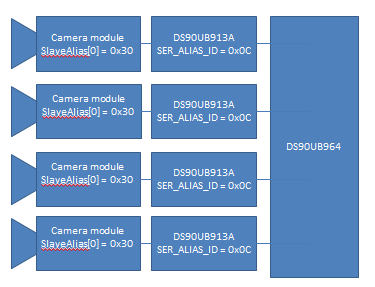Hello,
According to the data sheet "8.5.3 Broadcast Write to Remote Devices", if we run the
"8.5.3.1 Code Example for Broadcast Write" on UB964, I2C address of all serializers
(Ex.DS90UB913) become 0x0C. So, there are many seializers that same I2C address (0x0C) on I2C bus.
In this case, we can use the broadcast write, if we write the data in 0xC of I2C address.
This is my understanding about broadcast mode at DS90UB964.
I have some questions about broadcast mode at DS90UB964.
1. Why can DS90UB964 write right data to all serializer?
Please let me know the mecanisumu of this.
2. Can DS90UB964 receive ACKs from all serializer?
3. Can DS90UB964 confirm that I2C communication did not work, if one of serializer does not work?
Regards,
Nao



